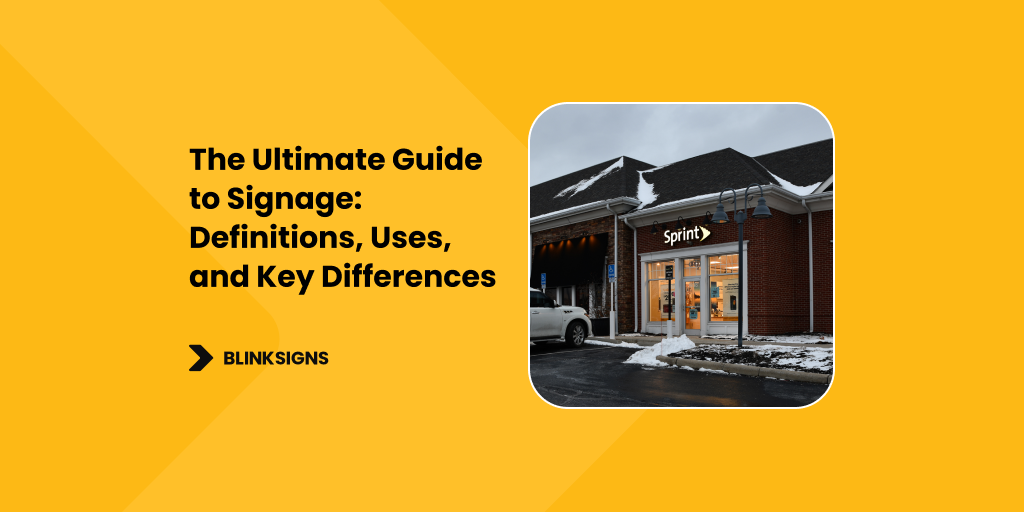
The Ultimate Guide to Signage: Definitions, Uses, and Key Differences
At BlinkSigns, we know that signage is more than just putting up a sign—it’s about creating powerful first impressions, driving brand visibility, and ensuring your message stands out in any environment.
Whether you’re looking to enhance customer navigation, promote your latest offers, or simply make your business impossible to miss, the right signage makes all the difference.
But what exactly goes into effective signage, and how can you leverage it to elevate your business?
In this ultimate guide to signage, we’ll take you through the key types of signage, their impact on customer engagement, and why investing in the right signage solutions is critical for your brand’s success.
If you’re ready to make your mark with signage that truly works, let’s get started.
What Does Signage Include?
Signage encompasses a broad array of visual displays used to communicate messages to an audience. It can range from simple directional signs to large-scale digital displays that promote products, services, or events. Signage includes informational signs, promotional signs, regulatory signs, and wayfinding systems.
Whether they are static signs such as billboards or dynamic signs like digital kiosks, signage is essential for businesses to effectively engage with their customers. From retail environments to corporate offices, signage helps convey critical information in a visually appealing manner that is easy to understand.
The versatility of signage allows businesses to tailor their communication to various purposes. For example, outdoor signs are designed to attract attention from a distance, while indoor signs may provide detailed information to assist with customer navigation or product promotion. By choosing the right type of signage, companies can enhance their branding and improve the overall customer experience.
What Are the Three Main Categories of Signage?
Signage can be broadly categorized into three primary types: informational signage, directional signage, and promotional signage. These categories are essential for businesses to communicate effectively with their target audience.
- Informational Signage: This type of signage provides important details, such as store hours, policies, or product descriptions. It is particularly useful in customer service areas, hospitals, and corporate settings where clarity is essential.
- Directional Signage: Also known as wayfinding signage, this type helps people navigate through a space. Examples include exit signs, floor directories, and restroom signs in malls, airports, and office buildings.
- Promotional Signage: This type of signage is designed to advertise and promote products, services, or special offers. Businesses use billboards, window displays, and digital signage to attract attention and drive sales.
By understanding these categories, businesses can strategically implement signage that serves specific purposes, ensuring their audience receives the right information at the right time.
Does Signage Mean Exposure?
Yes, signage plays a significant role in increasing brand exposure. For businesses, well-placed signage in high-traffic areas or prominent locations is a valuable tool for gaining visibility and attracting new customers.
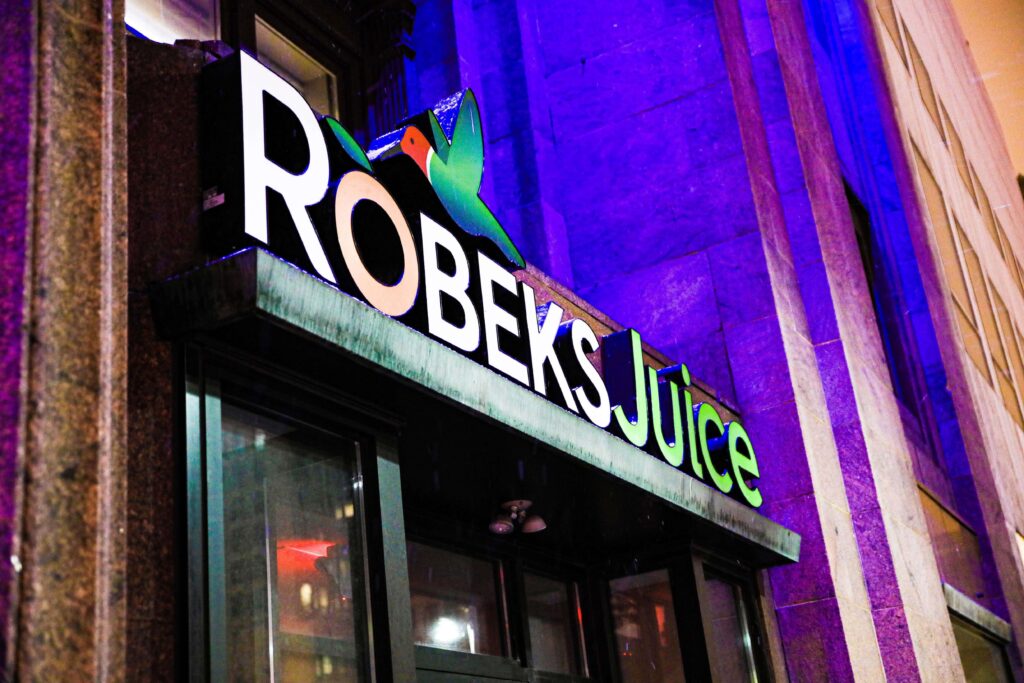
Robeks juice signage
Signage serves as a continuous advertisement, functioning 24/7 to remind potential customers of a brand’s presence. Whether through billboards on highways or digital displays in busy shopping centers, signage ensures that businesses remain top-of-mind for those who pass by.
In addition to increasing foot traffic, signage also enhances brand recognition. Repeated exposure to a company’s logo, colors, and message through signage reinforces brand identity and helps customers remember the business when making purchasing decisions.
Effective signage acts as a silent salesperson, promoting your brand and products to a broad audience without any direct interaction.
What Does Signage Mean at Workstations?
In the context of workstations, signage refers to displays that provide employees with essential information about safety procedures, operational guidelines, and regulations.
These signs are crucial in industries such as manufacturing, warehousing, and construction, where maintaining a safe and compliant work environment is critical.
Safety signs, warning labels, and emergency instructions help ensure that employees are aware of potential hazards and know how to respond appropriately in emergency situations.
In corporate settings, workstation signage may also include motivational signs, company policies, or employee recognition boards.
These signs serve to improve workflow efficiency and foster a positive workplace culture by keeping employees informed and engaged. By integrating signage into workstations, businesses can enhance productivity while ensuring that safety and operational standards are consistently met.
What Category Does Signage Fall Under?
Signage can fall under several categories depending on its intended purpose. Primarily, signage is classified as a marketing tool when used for advertising or promotional purposes. In this context, businesses leverage signage to attract customers, promote products, and reinforce their brand identity. Outdoor signs like billboards and window displays are typically used to engage a broad audience, while indoor signs may focus on specific product promotions or point-of-sale information.
Signage also falls under the category of regulatory compliance when used in safety or informational contexts. For example, OSHA-compliant safety signs are required in many industries to communicate hazards and emergency procedures.
Lastly, signage can be categorized under architectural elements, as it often plays a role in the design and aesthetic of commercial spaces, integrating branding with functional information.
What Are Signage Displays?
Signage displays are the mediums through which messages are conveyed. These can range from static posters and banners to dynamic digital screens and interactive kiosks. Depending on the environment and the target audience, signage displays can be tailored to specific needs. For instance, LED displays are commonly used in high-traffic areas to showcase rotating advertisements or real-time updates, while printed signs may be used indoors for longer-term communication, such as store hours or policy guidelines.

Hibachi signage
Signage displays are a critical aspect of visual communication, as they need to be both eye-catching and informative. Whether it’s a traditional sign or a modern digital display, the goal is to ensure that the message is easily understood by the intended audience. Choosing the right signage display depends on factors such as the location, viewing distance, and content complexity.
What Does Good Signage Mean?
Good signage means more than just attractive visuals. It encompasses a combination of clarity, visibility, and strategic placement to ensure that the message is effectively communicated to the target audience.
Effective signage is easy to read, with clear fonts, contrasting colors, and appropriate sizing that allows viewers to quickly absorb the information. Whether the goal is to inform, promote, or guide, good signage makes the message stand out without overwhelming the audience.
In addition to visual appeal, good signage also takes into consideration the environment in which it is placed. Outdoor signage needs to be durable and weather-resistant, while indoor signage should align with the overall aesthetics of the space.
Digital signage, on the other hand, offers the advantage of dynamic content that can be updated in real-time, allowing businesses to tailor their messaging to changing needs. Good signage ultimately enhances the customer experience by providing clear, concise, and engaging information.
What Are the Three Types of Signs?
There are three primary types of signs that businesses commonly use:
| Category | Purpose | Examples | Common Locations |
| Informational Signage | Provides essential information to help customers or visitors understand policies, navigate spaces, or find important details. | – Store hours signs
– Safety regulations signs – Menu boards in restaurants – Restroom signs |
– Retail stores
– Corporate offices – Hospitals – Restaurants |
| Directional (Wayfinding) Signage | Guides people to navigate through physical spaces, ensuring ease of movement and reducing confusion. | – Floor directories in malls
– Exit signs – Restroom direction arrows – Parking lot signs |
– Shopping malls
– Airports – Office buildings – Large event venues |
| Promotional Signage | Highlights products, services, or special offers to attract customers and drive sales. | – Billboards
– Window displays – Digital advertising screens – POP (Point-of-Purchase) displays |
– Retail stores
– High-traffic streets – Sports stadiums – Convention centers |
Understanding these three types allows businesses to choose the best option based on their marketing strategy and environment.
When to Use Signs and Signage?
Businesses should use signs and signage whenever they need to communicate, promote, or direct. Signs are essential tools for enhancing customer experience, providing crucial information about a company’s products or services, and guiding customers within physical spaces. Wayfinding signs are critical in large spaces like malls, airports, and hospitals, while promotional signage is essential for retail businesses looking to highlight special offers or new products.
In addition, regulatory signage is necessary for ensuring safety and compliance in workplaces. Businesses should use signage not only for promotional purposes but also to ensure smooth navigation and operational efficiency. Digital signage can be used in real-time to provide updated information, while static signage can offer long-term solutions for branding and wayfinding.
What Do You Use Signage For?
Signage is used for a variety of purposes, from advertising to informing and guiding. In retail, signage plays a critical role in promoting products, highlighting sales, and enhancing brand visibility. For public spaces, signage is used to provide directions, safety instructions, and informational content to ensure people can navigate and access what they need.
Signage is also used for regulatory compliance, ensuring that businesses meet safety standards and provide clear instructions for emergencies. In addition to these functional purposes, signage can also enhance the aesthetics of a space, contributing to a cohesive brand identity and customer experience.
What Is the Difference Between Signs and Signage?
Signs are individual units that display specific information, while signage refers to a collection of signs working together as part of a broader communication strategy. For example, a single menu board in a restaurant is a sign, but all the signs within that restaurant—menu boards, exit signs, restroom signs—make up the signage system.
Signage emphasizes the strategic use of signs in an organized manner, providing a cohesive message to customers or visitors. Signs are the individual tools, while signage is the collective effort to create a unified communication system. This distinction is important for businesses when developing their signage strategy, ensuring that each sign complements the overall message.
What Is the Signage System?
A signage system refers to the entire network of signs that work together to guide, inform, or promote within a specific environment. Unlike a single sign, a signage system is a coordinated effort to ensure that information is conveyed consistently and effectively across various locations. This system can include a mix of wayfinding signs, informational displays, promotional signage, and safety signs, all designed to work together seamlessly.
For example, in a large hospital, the signage system might include directional signs guiding patients to different departments, safety signs ensuring compliance with health and safety regulations, and informational signs providing details about services.
A well-designed signage system ensures that people can navigate a space easily, while also enhancing the brand’s visibility and reinforcing the company’s values. Whether in corporate offices, shopping malls, or universities, an effective signage system creates a cohesive experience for visitors and customers alike.
What Is Signage Use?
Signage use refers to how signs are employed in various contexts to achieve specific goals, such as informing, promoting, guiding, or complying with regulations. Businesses use signage to attract customers, provide crucial information, or ensure safety within their spaces.
In retail, signage use is focused on advertising products and promoting sales, while in corporate environments, signage is often used for wayfinding and regulatory compliance.
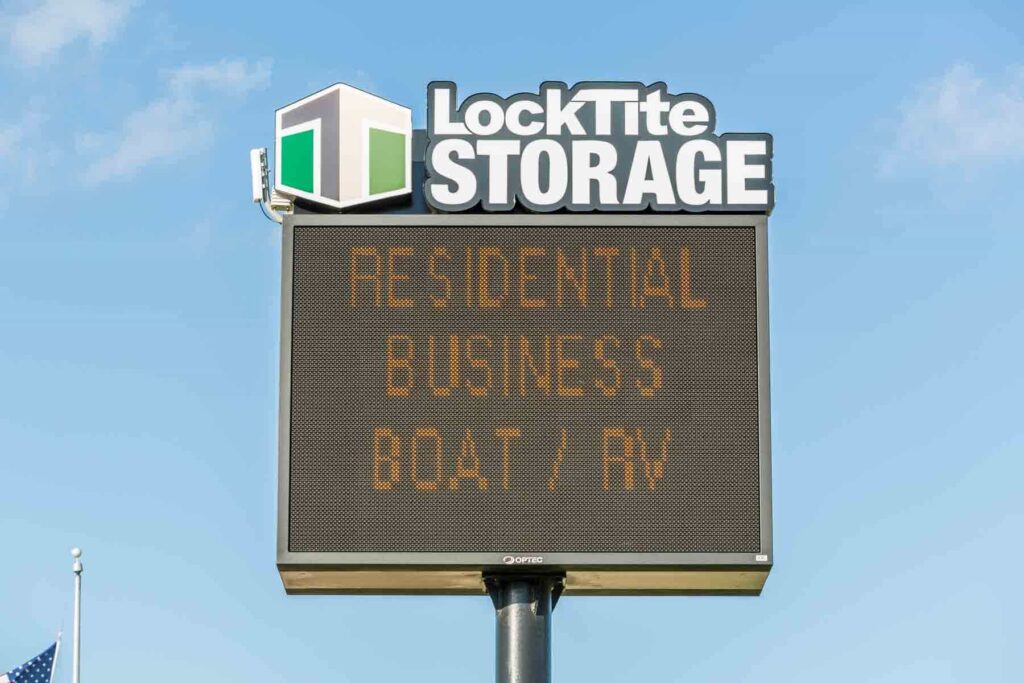
locktite Storage EMC signage
For example, wayfinding signs are essential in large venues to help visitors navigate, while digital signage in a retail store can promote limited-time offers and improve the customer experience. The use of signage can also be regulatory, where businesses are required to display safety instructions, emergency exits, and hazard warnings to meet legal requirements.
Effective signage use combines aesthetics with functionality, ensuring that the message is clear and easy to follow while enhancing the overall environment.
When Did Signage Become Signage?
Signage as we know it today has evolved over centuries, but its roots can be traced back to ancient civilizations, where symbols and signs were used to denote marketplaces, temples, and important public spaces. Over time, the use of signs expanded, and with the rise of urbanization and commerce during the Industrial Revolution, signage became a formalized tool for businesses to attract customers and convey information.
By the mid-20th century, signage had transitioned from simple, hand-painted signs to more sophisticated displays, including illuminated signs, billboards, and eventually, digital signage. The word “signage” started to be used more frequently during this period to describe a system of signs that work together within a particular space.
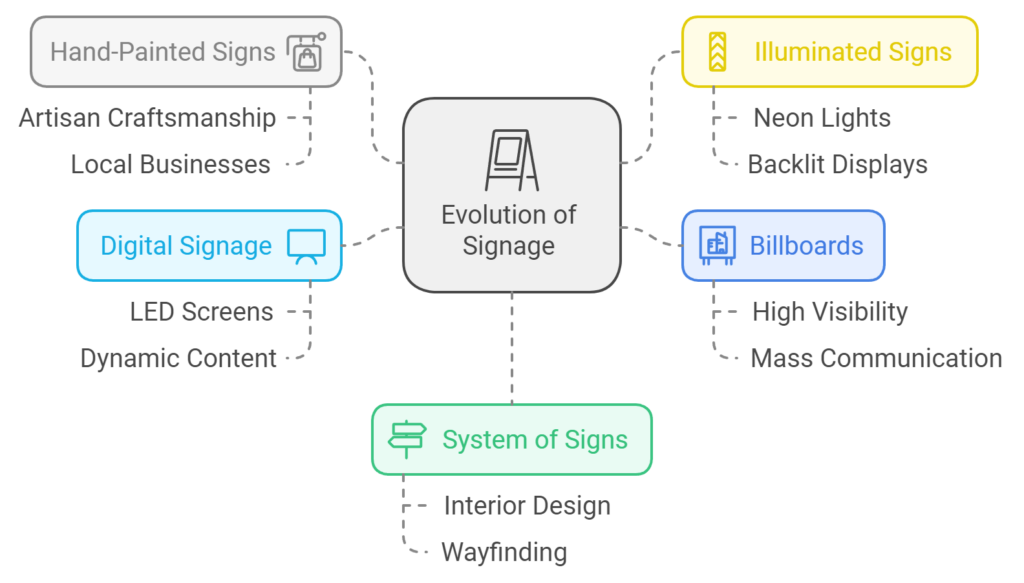
Evaluation of signage
The concept of signage today refers not only to individual signs but to the entire strategy of visual communication that businesses and public institutions rely on to engage with their audience.
What Is the Difference Between Signage and Symbols?
Signage and symbols are both important elements of visual communication, but they serve different functions. Signage refers to the broader system of signs used to communicate information, while symbols are graphical representations that convey specific meanings without the need for text. For example, a bathroom symbol (a figure of a man or woman) is a symbol used within signage to indicate restroom locations.
Symbols are often used in signage because they can be universally understood, crossing language barriers and providing instant recognition. Road signs, airports, and public transportation rely heavily on symbols to communicate essential information quickly and efficiently.
While signage can include both text and symbols, symbols alone are often used when clarity and speed are important, such as in safety or wayfinding signage.
What Is the Correct Term for Sign?
The correct term for an individual sign is simply “sign.” A sign is any object, display, or device that conveys information, instructions, or promotional content to an audience. Signs are used across a wide range of industries, from retail and hospitality to healthcare and public transportation. A sign could be a simple poster, an illuminated storefront display, or a digital board displaying dynamic content.
While signage refers to the collective system of signs, the word sign is used to describe one unit within that system. For businesses, choosing the right sign for their specific needs—whether it be for promotion, direction, or safety—is crucial to effectively communicating with their audience.
What Is the Difference Between Signage and a Banner?
The primary difference between signage and a banner lies in their form and purpose. Signage is a broad term that encompasses all types of signs, whether they are static or digital, informational or promotional.
It includes everything from directional signs and safety signs to digital kiosks and billboards. Banners, on the other hand, are a specific type of signage used primarily for promotions or special events. They are typically printed on vinyl or fabric and hung temporarily to advertise sales, grand openings, or seasonal promotions.
While a banner is a part of the broader category of signage, it is generally used for short-term messaging. Storefront banners, for instance, can be hung to promote limited-time offers or new product launches, whereas other types of signage, like monument signs or digital displays, may serve more permanent or long-term purposes.
Is Signage Considered Advertising?
Yes, signage is often considered a critical form of advertising. Businesses use signage to promote their products, services, and brand to potential customers in both indoor and outdoor environments. Promotional signage, such as billboards, window displays, and digital signage, is specifically designed to capture attention and drive interest. In retail, signage serves as an essential part of point-of-purchase advertising, encouraging impulse buys or highlighting special offers.
Signage advertising is one of the most effective ways to reach a broad audience, especially in high-traffic areas. A strategically placed billboard along a busy highway or a digital screen in a shopping mall can generate significant brand exposure. Businesses rely on signage to continuously advertise their products and services, making it a key element of outdoor advertising campaigns.
Is Billboard a Signage?
Yes, a billboard is a type of signage. Billboards are large-scale signs used primarily for outdoor advertising, typically placed in high-traffic areas such as highways, city streets, or near shopping centers. Billboards are designed to capture the attention of drivers and pedestrians by conveying simple, impactful messages that can be understood quickly.
Billboards are an effective form of promotional signage because they offer continuous exposure to a large audience, ensuring that the business’s message is seen by thousands of people every day. With advancements in technology, digital billboards have become popular, allowing businesses to display dynamic content that changes in real-time, offering even greater flexibility in their advertising strategy.
What Is the Difference Between Signage and a Signpost?
The difference between signage and a signpost lies in their specific roles. Signage refers to the visual display that communicates a message—this could be an advertisement, directional sign, or safety warning. Signposts, on the other hand, are the physical structures that hold up or support the signage. For example, a directional road sign is the signage, while the pole or post that it is mounted on is the signpost.
Signposts are essential for ensuring that signs are properly positioned, visible, and secure, particularly for outdoor signage in public spaces or along highways. While signage delivers the message, the signpost ensures that the sign is sturdy, well-placed, and easily seen by the target audience.
What Is Commercial Signage?
Commercial signage refers to all types of signs used by businesses to promote their products, services, or brand. This type of signage is designed to enhance customer awareness, increase sales, and improve brand visibility. Storefront signs, window displays, digital signs, and billboards all fall under the category of commercial signage.
Businesses use commercial signage to create a visual identity, attract foot traffic, and communicate with customers. For example, retail stores rely heavily on promotional signs to advertise sales, while restaurants use menu boards and special displays to inform customers of their offerings. Digital signage is also a popular tool in commercial environments, offering the ability to display dynamic content and real-time updates.
What Is Signage and Its Meaning?
Signage refers to the system of signs used to convey information, provide directions, or promote products and services. The meaning of signage extends beyond just the individual signs; it represents the overall visual communication strategy employed by businesses and public institutions to engage with their audience.
Signage includes informational signs, promotional displays, wayfinding signs, and safety instructions, all designed to communicate specific messages.
The importance of signage lies in its ability to convey information clearly and efficiently, whether it’s advertising a new product, guiding visitors through a space, or ensuring compliance with safety regulations.
Effective signage not only enhances the customer experience but also helps businesses maintain a consistent brand identity across multiple touchpoints.
What Is the Basic Definition of Signage?
The basic definition of signage is a collection of visual displays used to convey information, directions, or promotional messages. Signage includes everything from static signs, like banners and billboards, to digital displays that showcase dynamic content.
Signage is essential for businesses to communicate with their target audience, whether it’s to promote products, guide visitors, or provide important safety information.
In a broader sense, signage serves as a vital tool in marketing, branding, and customer engagement, helping businesses reach their goals while improving user experience.
What Does Signage Mean as a Word?
The word “signage” refers to a system of signs used to communicate messages in public, commercial, or business environments. It describes the collective group of signs that work together to inform, promote, or guide an audience.
The term emphasizes the strategic use of visual communication, where multiple signs work cohesively to convey information to a specific audience, such as customers, employees, or visitors.
Signage is not just about individual signs—it’s about creating a comprehensive system that delivers the right message, at the right time, to the right people. Whether it’s used in retail, corporate offices, or public spaces, the word “signage” highlights the importance of cohesive communication through visual displays.
How Do You Use the Word Signage?
The word “signage” is used to describe a collection or system of signs in a particular environment. For example, you might say, “The signage in the mall helps customers find their way easily,” or “We need to improve the store’s signage to make it more visible to passersby.” It’s a versatile term that is used in a variety of contexts, from business marketing to wayfinding and compliance signage.
The word is commonly used in industries like retail, hospitality, healthcare, and corporate environments to describe the visual communication tools that enhance the customer experience and ensure that information is easily accessible.
What Are Examples of Moving Signs?
Moving signs refer to dynamic signage that captures attention through motion or digital animations. Some examples include:
- LED billboards that rotate between different advertisements.
- Scrolling message boards are used in public places like airports or shopping malls to display real-time updates.
- Digital signs that show animated graphics or video content to engage viewers.
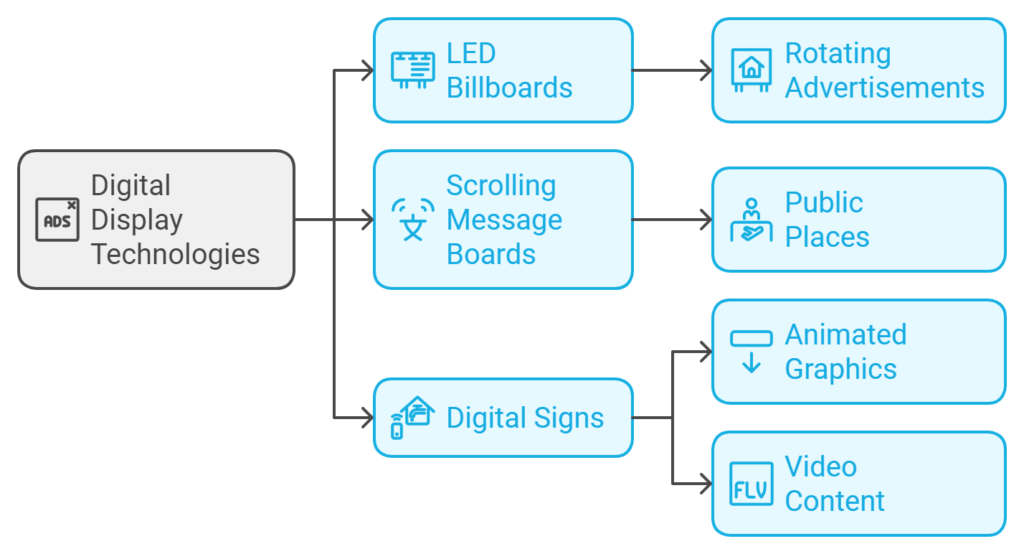
Digital Display technology
These types of signage are commonly used in urban areas, transit stations, retail spaces, and stadiums where capturing attention is crucial. Moving signs are an effective way to increase engagement and reach a larger audience by providing constantly changing content.
What Is the Difference Between Signage and Labels?
The difference between signage and labels lies in their scope and application. Labels are typically smaller, used for identification or classification purposes, such as product labels, price tags, or shelf labels in a retail store. Labels provide detailed information about specific items, such as ingredients, usage instructions, or pricing.
Signage, on the other hand, serves a broader purpose. It includes large-scale promotional displays, wayfinding systems, and safety signs designed to communicate with a wider audience. While labels focus on individual products or items, signage addresses larger themes, such as brand promotion, customer guidance, or regulatory compliance.
What Is the Correct Word for Displaying Something?
The correct term for the act of displaying information in public spaces is “signage.” Signage is used to describe the system of signs that communicate information, advertisements, or directions to a specific audience.
What Is It Called When Someone Signs a Document?
When someone signs a document, the action is referred to as “signing” or “authorization.” The individual provides their signature, which serves as a formal acknowledgment or agreement to the terms of the document. This is a common practice in legal, business, and financial settings where a signature is required to finalize agreements or verify identity.
Conclusion
At BlinkSigns, we believe that every sign tells a story—your story. Whether it’s a bold outdoor sign that draws customers in or well-placed indoor signage that enhances their experience, the right signage not only informs but also inspires.
From increasing brand visibility to improving customer engagement, signage is a powerful tool that no business should overlook.
As you’ve seen throughout this guide, understanding the types of signage and their impact is crucial to making smart, effective choices for your business.
If you’re ready to take your brand to the next level with signage that captures attention and drives results, we’re here to help. Contact BlinkSigns today, and let’s create signage solutions that truly work for your business.